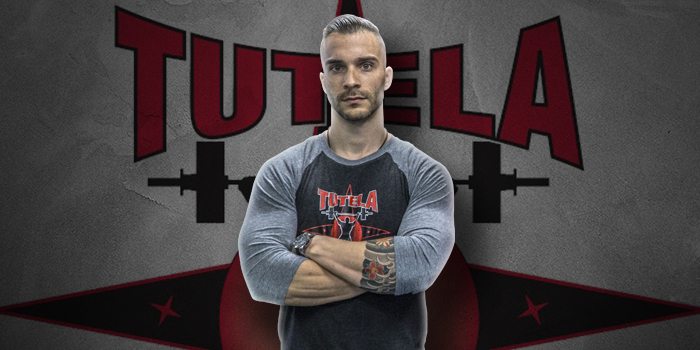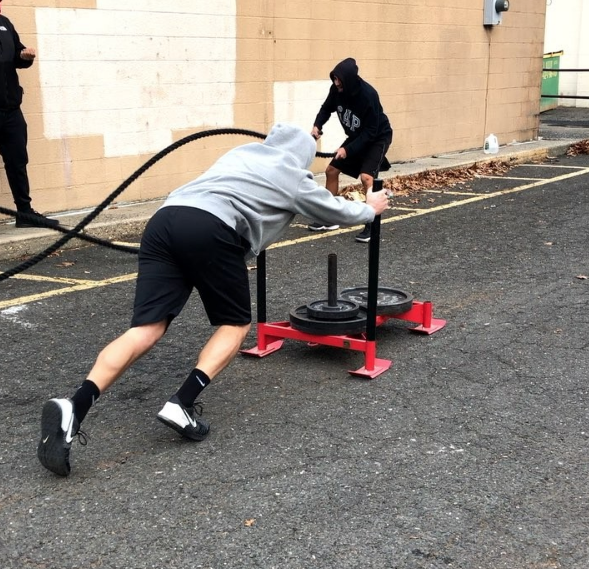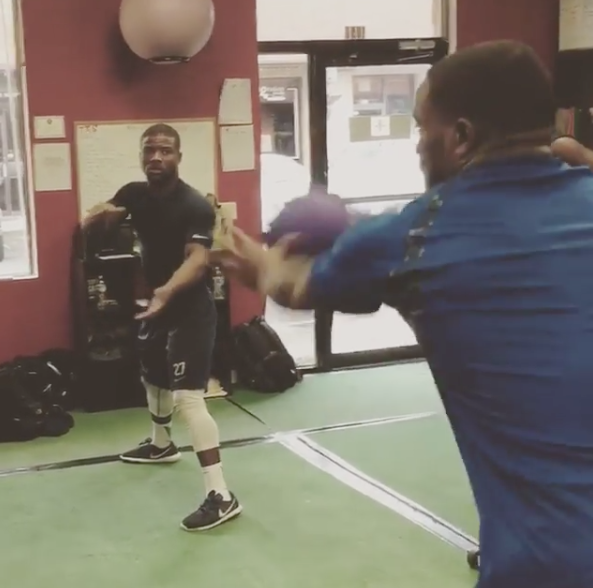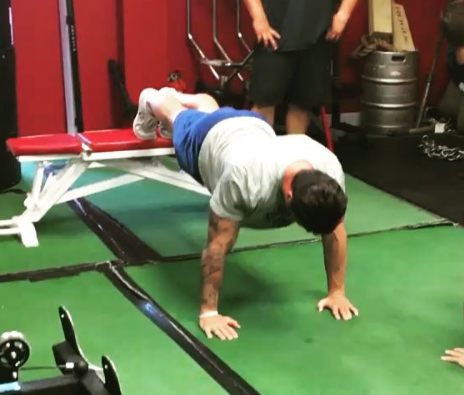
Being jacked and shredded to the bone is an awesome look. However, unless you’re a competitive bodybuilder, most guys still want their training to enhance their ability to move and perform, whether that be for their job, sport, or just being able to play with their kids. This essentially means that you want to be lean, muscular, strong, and conditioned, with the ability to move without pain. So what do you need to do in order to accomplish these different levels of fitness? Well, that is a very general question, because there are many variables involved. Age, training age, training level, and medical history are some of the things to take into consideration when designing the training program that will give you the best bang for your buck. However, there are some general guidelines that I’d like to address in order for you to make sure you’re training efficiently; to get the look you want with the strength and performance to back it up.
RECENT: Rules for the Hard Gainer, Part Two — Six New Steps to Packing on Mass
So, let’s start with this: Since everyone has different training capabilities and limitations, let’s take a look at the specific movement patterns that mostly everyone should be doing, rather than specific exercises.
- Squat
- Hinge
- Press
- Lunge
- Pull
- Carry
- Drag
- Push
- Jump
- Throw
- Shrug
- Plank
These are the primary movements that just about everybody could and should be incorporating in their program. Let’s look a little deeper into each one.
Squat
Not everyone should be squatting, deadlifting, or pressing with a barbell. Between the heavy spinal loading and joint restriction, certain movements with a straight bar can be disastrous for some. However, if you don’t have beat up joints or if you move well and pain free, you should absolutely take advantage of the benefits that come along with big barbell movements. That is, if you know how to move properly and with sound technique.
If you’re one of those who can’t get through certain exercises with a straight bar pain-free, there are plenty of alternatives out there. In this case, rather than a barbell squat, you can incorporate goblet squats, landmine squats, or maybe even SS Yoke Bar squats. The important thing is that you are using the squat variation that works best for you, but squatting nonetheless.
Hinge
If you struggle with a straight bar deadlift from the floor, you can pull from the rack or mats, use a trap bar, or spend more time on Romanian deadlifts, swings, pull-throughs, back extensions, or glute hamstring raises.
Press
Have shoulder pain when benching? Move over to dumbbells with a neutral grip as your primary exercise for the day. Maybe try a floor press or use a specialty bar like a Swiss bar or the American Press Bar. The neutral handles can make pressing much less restrictive and joint-friendly. The point is you don’t have to be purely set on the barbell bench, squat, and deadlift as your primary exercises. It’s more important to focus on the movement pattern and use the variation that works best for you. You can still follow the progressive overload principle and you can still work hard; you’ll just be working a bit smarter and with exercises that don’t cripple you for weeks. You certainly don’t have to be married to the straight bar.
Pull
Pulling refers to both horizontal and vertical pulling, such as rows, pulldowns, chin-ups, and pull-ups. Often times people neglect to train their backs properly by either going too heavy or using piss poor technique. Learn to row properly by getting full protraction and retraction of the scapula while maintaining a neutral spine and not turning the exercise into a biceps curl. For optimal shoulder health, pull twice as much as you press.
Lunge
Unilateral work like lunges should also be a staple in your program for optimal strength and performance. These can vary between split squats, walking lunges, Bulgarian split squats, side lunges, and alternating lunges, but the variation that people typically don’t have any issues with is the reverse lunge.
Drag and Push
Sled dragging and pushing are great for many reasons, including recovery work. But I also like them due to the fact that there is no eccentric component, which means you can get a great lower body strength workout in without being too sore to take a shit for three days. Most people have no issues with sled work and it is a tremendous tool for your training arsenal.
Carry
Loaded carries are great for packing size on your traps, developing your grip, and enhancing core strength and stability. Use different carry variations for optimal core strength.
Jump and Throw
Using a variety of jumps and throws can be critical for your performance and athletic ability. They are also a great way to work on your power development if you’re too beat up for Olympic lifting or if you just don’t have time to learn the lifts. Just be sure to learn how to jump and land properly. Jumping and throwing are also great ways to kick off your workout (after a thorough warm-up, of course) to excite your CNS and help prepare for the heavier strength work coming your way.
Shrug and Plank
Pretty self-explanatory here. Just about everyone can do these two without issue.
So, now that we've got all of the movement patterns out of the way, let’s talk about tying them together to maximize your strength and performance.
Balance
To optimize your physique and performance, you need a balanced program. One of my favorite training splits is an upper/lower four-day split over a three-day training week. So one week will be upper, lower, upper, and the following week will be lower, upper, lower. This is awesome for guys who have been training for a while due to the time it gives you to recover between training sessions. But it’s also highly effective for anyone.
On upper body days, do a horizontal pull movement for every horizontal press. Remember to do twice the amount of total volume on your horizontal pulls than your presses to ensure optimal shoulder health. Then on days you are vertical pressing, do a vertical pull for every press. Again, do twice the volume on the pulling.
On lower body days, focus on the movements we discussed and try to balance out your squat and hinge patterns. Also, don’t forget to work on your unilateral work. Typically lower body days are when I work in my shrugs and abdominal work.
Progress
Regardless of which exercise variation you’re using, the key to your training success will be the progressive overload principle. If you are unsure what that is, just try to add weight or reps each week. Be sure to keep a training log so you can keep a close eye on your progress. If you’re an older lifter you don’t have to always try to crush one-rep maxes to hit a PR. I am with you that PRs are important, but work in stuff like a rep-test PR with a specific weight or reps on a pistol squat rather than constantly loading your spine week after week.
Conditioning
Don’t make the mistake of turning your strength training session into a cardio session. That’s a sure way to get weak as piss. However, on your days off from the gym, you've got to get some cardio or conditioning work in if you want to get shredded and have the ability to perform. There are many ways you can do this. You can do some sort of sprint variation, jump rope, do a met-con circuit, use a Prowler, hike, bike, or even swim.
Or, you can work in some kind of stationary cardio on a bike or elliptical from time to time. Just keep in mind that this won’t do much for your performance and will be strictly done to burn fat and kick up your heart rate. Rather than taking the steady-state approach, you’re better off working in some kind of interval. I prefer using a three-to-one “rest” to work ratio. For example, you can pedal a bike on a light resistance for 90 seconds, then increase the resistance and sprint for 30 seconds, then drop it back down to the lighter resistance for 90 seconds and repeat for 20 to 30 minutes. The most fun way is by playing a sport or martial art to get your conditioning in, so be sure to consider that as well. However, if you are suffering from joint pain it’s important to use more low impact stuff like the stationary bike or swimming rather than running hills.
If you’re getting three days of strength work in then I recommend getting three days of cardio or conditioning in. Just keep an eye on the intensity of your conditioning and take it easier on one of the days to ensure proper recovery.
Recovery
We all know that recovery is vital for muscular growth and overall well-being. Sleep seven to nine hours per night, get a massage, foam roll and work in self-myofascial release techniques, take contrast baths, and take a day off when you need it.
Warm-Up and Stretch
Walking into the gym cold and hopping right in the squat rack is a disaster waiting to happen. Be sure to take a thorough dynamic warm-up prior to your training. Stretching is also key for optimal physical health. Going into depth on proper warm-ups and stretching techniques is way beyond the scope of this post, so check out Kelly Starrett's “Mobility WOD” on YouTube and grab a copy of his book Becoming a Supple Leopard to learn more.
Tying this all together is a great start to optimal performance. Looking great is always the goal, but it shouldn’t be achieved at the expense of your health. The end result should be looking great and feeling great.
If you have any questions, feel free to shoot me an email at info@tutela training.com or just drop a comment below.














1 Comment